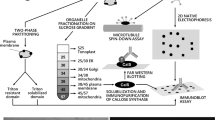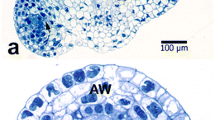Summary
The ultrastructure of the cytoskeleton inNicotiana alata pollen tubes grownin vitro has been examined after rapid freeze fixation and freeze substitution (RF-FS). Whereas cytoplasmic microtubules (MTs) and especially microfilaments (MFs) are infrequently observed after conventional chemical fixation, they occur in all samples prepared by RF-FS. Cortical MTs are oriented parallel to the long axis of the pollen tube and usually appear evenly spaced around the circumference of the cell. They are always observed with other components in a structural complex that includes the following: 1. a system of MFs, in which individual elements are aligned along the sides of the MTs and crossbridged to them; 2. a system of cooriented tubular endoplasmic reticulum (ER) lying beneath the MTs, and 3. the plasma membrane (PM) to which the MTs appear to be extensively linked. The cortical cytoskeleton is thus structurally complex, and contains elements such as MFs and ER that must be considered together with the MTs in any attempt to elucidate cytoskeletal function. MTs are also observed within the vegetative cytoplasm either singly or in small groups. Observations reveal that some of these may be closely associated with the envelope of the vegetative nucleus. MTs of the generative cell, in contrast to those of the vegetative cytoplasm, occur tightly clustered in bundles and show extensive cross-bridging. These bundles, especially in the distal tail of the generative cell, are markedly undulated. MFs are observed commonly in the cytoplasm of the vegetative cell. They occur in bundles oriented predominantly parallel to the pollen tube axis. Although proof is not provided, we suggest that they are composed of actin and are responsible for generating the vigorous cytoplasmic streaming characteristic of living pollen tubes.
Similar content being viewed by others
Abbreviations
- EGTA:
-
ethylene glycol bis-(β-aminoethyl ether), N,N,N′,N′-tetraacetic acid
- ER:
-
endoplasmic reticulum
- MF:
-
microfilament
- MT:
-
microtubule
- PEG:
-
polyethylene glycol
- PM:
-
plasma membrane
- RF-FS:
-
rapid freeze fixation-freeze substitution
References
Condeelis JS (1974) The identification of F-actin in the pollen tube and protoplast ofAmaryllis belladonna. Exp Cell Res 88: 435–439
Cresti M, Ciampolini F, Kapil RN (1984) Generative cells of some angiosperms with particular emphasis on their microtubules. J Submicrosc Cytol 16: 317–326
— —,Mulcahy DLM, Mulcahy G (1985) Ultrastructure ofNicotiana alata pollen, its germination and early tube formation. Am J Bot 72: 719–727
—,Hepler PK, Tiezzi A, Ciampolini F (1986) Fibrillar structures inNicotiana pollen: changes in ultrastructure during pollen activation and tube emission. In:Mulcahy DL, Mulcahy G, Ottaviano E (eds) Biotechnology and ecology of pollen. Springer, New York, pp 283–288
Derksen J, Pierson ES, Traas JA (1985) Microtubules in vegetative and generative cells of pollen tubes. Eur J Cell Biol 38: 142–148
Franke WW, Herth W, Woude WJ Van Der, Morre DJ (1972) Tubular and filamentous structures in pollen tubes: possible involvement as guide elements in protoplasmic streaming and vectorial migration of secretory vesicles. Planta 105: 317–341
Hardham AR, Green PB, Lang JM (1980) Reorganization of cortical microtubules and cellulose deposition during leaf formation inGraptopetalum paraguayense. Planta 149: 181–195
Heath IB, Seagull RW (1982) Oriented cellulose fibrils and the cytoskeleton: a critical comparison of models. In:Lloyd CW (ed) The cytoskeleton in plant growth and development. Academic Press, London, pp 163–182
Hepler PK, Palevitz BA (1974) Microtubules and microfilaments. Ann Rev Plant Physiol 25: 309–362
Herth W (1978) Ionophore A23187 stops tip growth, but not cytoplasmic streaming, in pollen tubes ofLilium longiflorum. Protoplasma 96: 275–282
—,Franke WW, Woude WJ Van Der (1972) Cytochalasin stops tip growth in plants. Naturwissenschaften 59: 38–39
Hoefert LL (1969) Fine structure of sperm cells in pollen grains ofBeta. Protoplasma 68: 237–240
Lancelle SA, Callaham DA, Hepler PK (1986) A method for rapid freeze fixation of plant cells. Protoplasma 131: 153–165
Mascarenhas JP, Lafountain J (1972) Protoplasmic streaming, cytochalasin B, and growth of the pollen tube. Tiss Cell 4: 11–14
Miki-Hirosige H, Nakamura S (1982) Process of metabolism during pollen tube wall formation. J Electron Microsc 31: 51–62
Perdue TD, Parthasarathy MV (1985)In situ localization of F-actin in pollen tubes. Eur J Cell Biol 39: 13–20
Picton JM, Steer MW (1981) Determination of secretory vesicle production rates by dictyosomes in pollen tubes ofTradescantia using cytochalasin D. J Cell Sci 49: 261–272
— — (1983) Evidence for the role of Ca2+ ions in tip extension in pollen tubes. Protoplasma 115: 11–17
— — (1985) The effects of ruthenium red, lanthanum, fluorescein isothiocyanate and trifluoperazine on vesicle transport, vesicle fusion, and tip extension in pollen tubes. Planta 163: 20–26
Pierson ES, Derksen J, Traas JA (1986) Organization of microfilaments and microtubules in pollen tubes grownin vitro orin vivo in various angiosperms. Eur J Cell Biol 41: 14–18
Reiss H-D, Herth W (1979) Calcium ionophore A23187 affects localized wall secretion in the tip region of pollen tubes ofLilium longiflorum. Planta 145: 225–232
— — (1982) Disoriented growth of pollen tubes ofLilium longiflorum Thunb induced by prolonged treatment with the calciumchelating antibiotic, chlortetracycline. Planta 156: 218–225
— — (1985) Nifedipine-sensitive calcium channels are involved in polar growth of lily pollen tubes. J Cell Sci 76: 247–254
Seagull RW, Heath IB (1979) The effects of tannic acid on thein vivo preservation of microfilaments. Eur J Cell Biol 20: 184–188
Tiezzi A, Cresti M, Ciampolini F (1986) Microtubules inNicotiana pollen tubes: ultrastructural, immunofluorescence, and biochemical data. In:Cresti M, Dallai R (eds) Biology of reproduction and cell motility in plants and animals. University of Siena, Siena, pp 87–94
Tiwari SC, Wick SM, Williamson RE, Gunning BES (1984) Cytoskeleton and integration of cellular function in cells of higher plants. J Cell Biol 99: 63 s-69 s
Traas J (1986) Microtubules in pollen tubes ofNicotiana tabacum grownin vitro. In: The cytoskeleton in plant cell growth, differentiation and cell wall synthesis. PhD Thesis, University of Nijmegen, pp 129–143
—,Braat P, Emons AMC, Meekes H, Derksen J (1985) Microtubules in root hairs. J Cell Sci 76: 303–320
Zhang H-Q, Croes AF (1982) A new medium for pollen germinationin vitro. Acta Bot Neerl 31: 113–119
Author information
Authors and Affiliations
Rights and permissions
About this article
Cite this article
Lancelle, S.A., Cresti, M. & Hepler, P.K. Ultrastructure of the cytoskeleton in freeze-substituted pollen tubes ofNicotiana alata . Protoplasma 140, 141–150 (1987). https://doi.org/10.1007/BF01273723
Received:
Accepted:
Issue Date:
DOI: https://doi.org/10.1007/BF01273723




